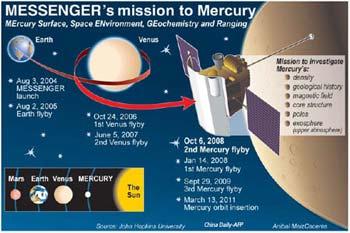Source: China Daily
05-04-2009 14:08
Special Report: Tech MaxWASHINGTON: The US space probe MESSENGER's second fly-by of the planet Mercury in October 2008 revealed the solar system's smallest planet to be far more active than previously thought, four studies said on Thursday.
 |
| The US space probe MESSENGER's second fly-by of the planet Mercury in October 2008 revealed the solar system's smallest planet to be far more active than previously thought, four studies said on Thursday. |
The MESSENGER (MErcury Surface, Space ENvironment, GEochemistry and Ranging) probe's cameras took more than 1,200 images of the surface, including details of a mammoth well-preserved 692-kilometer impact basin that shows signs of a volcanic past.
The so-called Rembrandt basin is the first such geological feature observed on Mercury where the ground is well exposed and not covered by a thick layer of volcanic ash, like most of the planet's other features.
"This basin formed about 3.9 billion years ago, near the end of the period of heavy bombardment of the inner solar system," said Thomas Watters from the Smithsonian Institution in Washington, a lead author of one of the studies, all of which are published in the May 1 edition of the journal Science.
"This second Mercury flyby provided a number of new findings," said Sean Solomon, the probe's principal investigator from the Washington-based Carnegie Institution.
